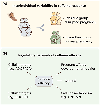Impacts of Caffeine during Pregnancy
- PMID: 31818639
- PMCID: PMC7035149
- DOI: 10.1016/j.tem.2019.11.004
Impacts of Caffeine during Pregnancy
Abstract
Epidemiological studies have revealed that caffeine consumption during pregnancy is associated with adverse gestational outcomes, yet the underlying mechanisms remain obscure. Recent animal studies with physiologically relevant dosages have begun to dissect adverse effects of caffeine during pregnancy with respect to oviduct contractility, embryo development, uterine receptivity, and placentation that jointly contribute to pregnancy complications. Interestingly, caffeine's effects are highly variable between individual animals under well-controlled experimental settings, suggesting the possibility of epigenetic regulation of these phenotypes, in addition to genetic variants. Moreover, caffeine exposure during sensitive windows of pregnancy may induce epigenetic changes in the developing fetus or even the germ cells to cause adult-onset diseases in subsequent generations. We discuss these research frontiers in light of emerging data.
Keywords: caffeine; embryo development; embryo implantation; epigenetic inheritance; epigenetic variation; oviductal transport.
Copyright © 2019 Elsevier Ltd. All rights reserved.
Figures




References
-
- Gonzalez de Mejia E and Ramirez-Mares MV (2014) Impact of caffeine and coffee on our health. Trends Endocrinol. Metab 25, 489–492 - PubMed
-
- Fredholm BB et al. (1999) Actions of caffeine in the brain with special reference to factors that contribute to its widespread use. Pharmacol. Rev 51, 83–133 - PubMed
-
- Frary CD et al. (2005) Food sources and intakes of caffeine in the diets of persons in the United States.J. Am. Diet. Assoc 105, 110–113 - PubMed
-
- Weng X et al. (2008) Maternal caffeine consumption during pregnancy and the risk of miscarriage: a prospective cohort study. Am. J. Obstet. Gynecol 198, 279. - PubMed

